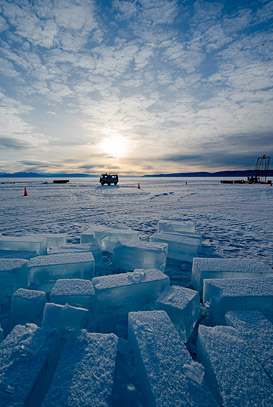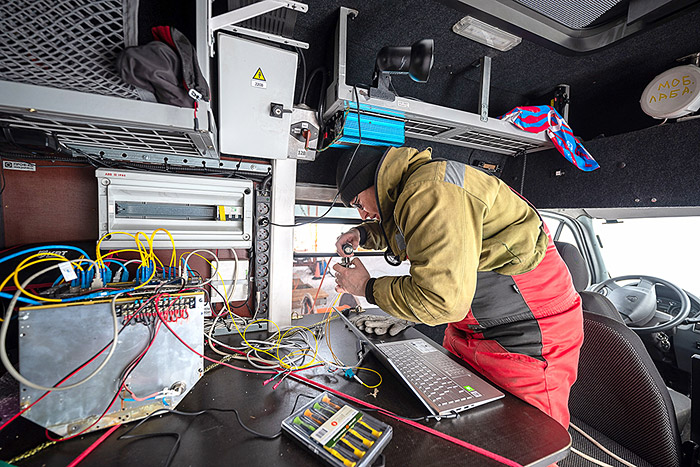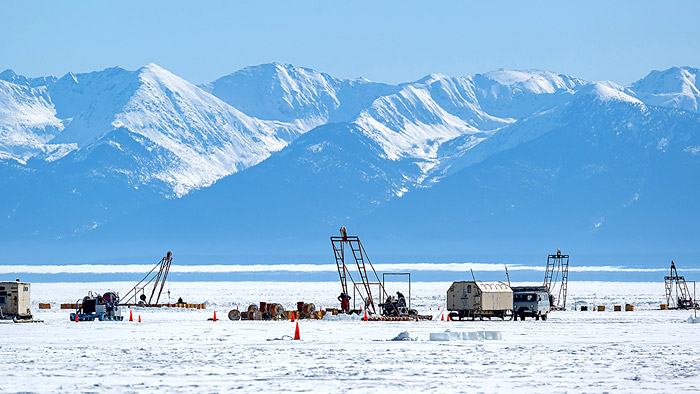
Electronic english version since 2022 |
The newspaper was founded in November 1957
| |
Projects of the XXI century
Results of the Baikal expedition
During the winter expedition of 2024, the Baikal-GVD collaboration installed another telescope cluster, deployed two intercluster garlands with laser calibration light sources, repaired and modernized already installed detector components, laid two bottom cables and carried out further work on the development of a cluster with a data transmission system along optical lines inside the facility. As part of the latter, together with Chinese colleagues from IHEP (Beijing), a pilot garland with components and organization of the data acquisition system of the next generation detector project was deployed.
 The Baikal-GVD neutrino telescope is designed to register and study ultra-high energy neutrino fluxes from astrophysical sources. Using it, scientists are going to study not only processes with enormous energy release that occurred in the distant past, but also the evolution of galaxies, the development of supermassive black holes and the mechanisms of particle acceleration.
The Baikal-GVD neutrino telescope is designed to register and study ultra-high energy neutrino fluxes from astrophysical sources. Using it, scientists are going to study not only processes with enormous energy release that occurred in the distant past, but also the evolution of galaxies, the development of supermassive black holes and the mechanisms of particle acceleration.
The Baikal Neutrino Telescope is a neutrino detector located in Lake Baikal at a distance of 3.6 km from the shore, at a depth of about 1300 m. This unique scientific facility is an important tool for multichannel astronomy - a new powerful technique for studying the Universe. Baikal-GVD is one of three operating large-scale neutrino telescopes in the world and along with the IceCube telescopes at the South Pole and KM3NeT in the Mediterranean, is part of the Global Neutrino Network (GNN).
The Baikal-GVD telescope is the largest in the Northern Hemisphere and the second largest in the world. To date, 13 clusters have been put into operation, positioned at a distance of 250-300 m from each other. Since 10 April, 2024, they have been operating in data acquisition mode. Each cluster is an independent detector of 8 vertical garlands on which optical modules are positioned (36 on each garland). According to the project, the facility volume by 2027-2028 should be about one cubic kilometer. Currently, the underwater structure of the facility contains just over 4.100 photodetectors.
"A prominent feature of this year's expedition was the use of detector components with forced substitution by available components due to known reasons. It resulted in unforeseen issues that however, were leveled out largely thanks to the professional experience of the team and the high-quality preparation of expeditionary work. During the expedition, only one complete cluster was installed, but the total amount of work carried out exceeded the labor costs of deploying two clusters. We hope that the data obtained from the installed prototype of the next-generation detector garland will allow us to better understand the physical capabilities of the future facility, as well as to estimate more soberly the tasks of its deployment and development of the required infrastructure," the expedition leader, Head of the Baikal GVD facility at DLNP JINR Igor Belolaptikov notes.

"The early production of a stable and durable ice cover of the lake allowed to increase the duration and volume of work implemented on the ice that in turn helped to cope with the tasks concerning the disruption of the established facility supply channels in recent years and to carry out the scheduled work plan of the expedition. A good step has been taken towards completing the stage of development of the efficient volume of the detector to the scale of a cubic kilometer and the first components of the next generation detector have been put to testing," Head of the collaboration, Corresponding Member of the Russian Academy of Sciences, Head of the Laboratory of High Energy Neutrino Astrophysics at the Institute of Nuclear Research of the Russian Academy of Sciences Grigory Domogatsky says.
The Baikal neutrino telescope Baikal-GVD is constructed through an international collaboration with the leading role of the Institute for Nuclear Research of the Russian Academy of Sciences, the founder of this experiment and the area of "high-energy neutrino astronomy" in the world and the Joint Institute for Nuclear Research.
In total, more than 70 scientists and engineers from nine research centres in Russia, the Czech Republic, Slovakia and Kazakhstan currently take part in the project. The 2024 expedition was organized by the Institute of Nuclear Research of the Russian Academy of Sciences and the Joint Institute for Nuclear Research.

dlnp.jinr.ru,
photo by Baira SHAYBONOVA